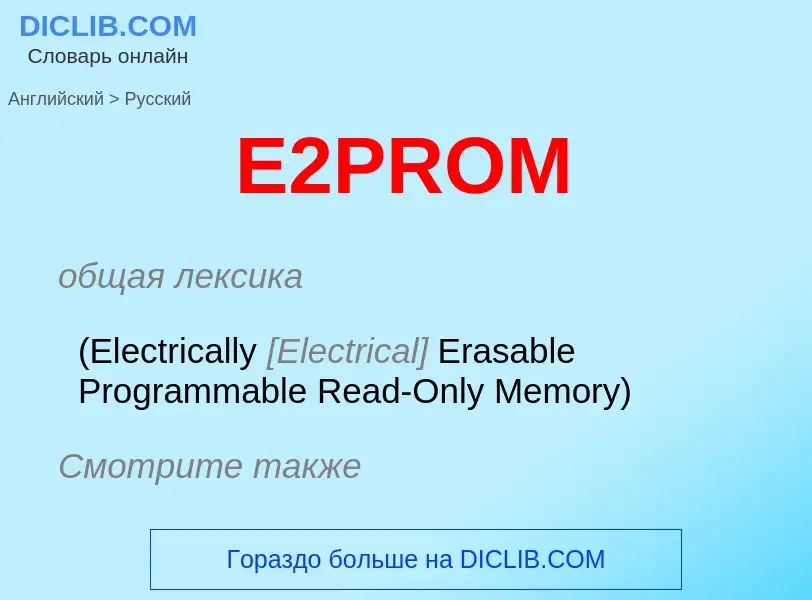Translation and analysis of words by ChatGPT artificial intelligence
On this page you can get a detailed analysis of a word or phrase, produced by the best artificial intelligence technology to date:
- how the word is used
- frequency of use
- it is used more often in oral or written speech
- word translation options
- usage examples (several phrases with translation)
- etymology
E2PROM - translation to russian
общая лексика
(Electrically [Electrical] Erasable Programmable Read-Only Memory)
Смотрите также
общая лексика
электрически стираемое программируемое постоянное запоминающее устройство, ЭСППЗУ, электрически стираемая память
редко используемый тип полупроводникового ППЗУ, в котором для стирания и перепрограммирования используется электрические сигналы, подаваемые либо из компьютера, либо с внешнего устройства (программатора) на специальные ножки микросхемы. Допускает от 10 до 100 тыс. циклов перезаписи. ЭСППЗУ было заметно вытеснено флэш-памятью
синоним
Wikipedia

EEPROM (also called E2PROM) stands for electrically erasable programmable read-only memory and is a type of non-volatile memory used in computers, usually integrated in microcontrollers such as smart cards and remote keyless systems, or as a separate chip device to store relatively small amounts of data by allowing individual bytes to be erased and reprogrammed.
EEPROMs are organized as arrays of floating-gate transistors. EEPROMs can be programmed and erased in-circuit, by applying special programming signals. Originally, EEPROMs were limited to single-byte operations, which made them slower, but modern EEPROMs allow multi-byte page operations. An EEPROM has a limited life for erasing and reprogramming, now reaching a million operations in modern EEPROMs. In an EEPROM that is frequently reprogrammed, the life of the EEPROM is an important design consideration.
Flash memory is a type of EEPROM designed for high speed and high density, at the expense of large erase blocks (typically 512 bytes or larger) and limited number of write cycles (often 10,000). There is no clear boundary dividing the two, but the term "EEPROM" is generally used to describe non-volatile memory with small erase blocks (as small as one byte) and a long lifetime (typically 1,000,000 cycles). Many past microcontrollers included both (flash memory for the firmware and a small EEPROM for parameters), though the trend with modern microcontrollers is to emulate EEPROM using flash.
As of 2020, flash memory costs much less than byte-programmable EEPROM and is the dominant memory type wherever a system requires a significant amount of non-volatile solid-state storage. EEPROMs, however, are still used on applications that only require small amounts of storage, like in serial presence detect.

![STMicro]] [http://www.st.com/resource/en/datasheet/m24c02-f.pdf M24C02] [[I²C]] serial type EEPROM STMicro]] [http://www.st.com/resource/en/datasheet/m24c02-f.pdf M24C02] [[I²C]] serial type EEPROM](https://commons.wikimedia.org/wiki/Special:FilePath/AT24C02 EEPROM 1480355 6 7 HDR Enhancer.jpg?width=200)
![die]] die]]](https://commons.wikimedia.org/wiki/Special:FilePath/ATMEL048 93C46A SC.jpg?width=200)
![MCU]] integrates 512 Byte EEPROM MCU]] integrates 512 Byte EEPROM](https://commons.wikimedia.org/wiki/Special:FilePath/Atmel-avr-atusb162-HD.jpg?width=200)
![SIM card]] SIM card]]](https://commons.wikimedia.org/wiki/Special:FilePath/Sim Chip.jpg?width=200)
